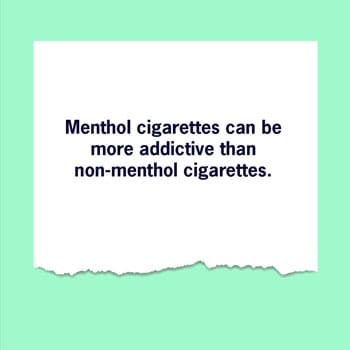Menthol Tobacco Products are a Public Health Problem
Menthol cigarettes, including how and to whom they are marketed and sold, are a significant risk to public health and advancing health equity due to their role in initiation, progression to regular smoking and dependence, reduced cessation success, and in contributing to health disparities.

The tobacco industry targets menthol cigarette marketing to certain populations through advertisements, giveaways, lower prices, lifestyle branding, and event sponsorships. For example, tobacco companies have heavily marketed in Black-owned publications, through sponsorship of jazz concerts and certain civil rights groups, through advertisements showing people dressed in clothing popular with rap and hip-hop artists, and in neighborhoods with more Black residents.1,2,3,4,5 These aggressive marketing tactics likely have contributed to some groups of people having higher rates of use than others. Given how menthol interacts with nicotine, people who smoke menthol cigarettes are also more likely to continue smoking, which puts them at higher risk of getting tobacco-related diseases.1,6,7
The tobacco industry uses similar strategies to market menthol cigars. For example, tobacco companies published advertisements in newspapers with a large proportion of readers who were Black persons. More recently, the industry has advertised menthol cigars on social media and has used hip-hop and rap artists, models, and music that are appealing to youth.2,8
No tobacco product is safe, including those with menthol. Despite this, tobacco companies market menthol cigarettes as “smoother” than other cigarettes, and marketing messages imply that menthol cigarettes are a “healthier” alternative.7
From 1980 – 2018, an estimated 10.1 million people started smoking in the U.S. because of menthol cigarettes and an estimated 378,000 people died prematurely.11
It is estimated that menthol cigarettes resulted in a total of 3 million years of potential life lost during this period.11
Menthol makes cigarettes more appealing and easier to smoke.9 In addition, menthol enhances the addictive effects of nicotine in the brain.9 The amount of nicotine, the addictive drug in tobacco products, in menthol cigarettes has increased in recent years.10
Menthol in cigarettes makes it more likely that youth and young adults will try smoking and that those who start smoking will continue to smoke on a regular basis.9
Tobacco companies have conducted extensive research on menthol. They adjust the amounts of menthol in cigarette brands to make each brand most appealing to the people they target. For example, the companies lowered the amount of menthol in some brands to make them more appealing to young people who smoke and those just starting to smoke. The companies increased the amount of menthol in other brands to make them more appealing to older people.12
Menthol in other tobacco products can also lead to continued use of those products. For example, youth and young adults whose first cigar was flavored with mint or menthol were 72% more likely to use cigars a year or more later compared to youth and young adults who reported their first cigar was not flavored.13
People who smoke menthol cigarettes can be less likely to successfully quit than people who smoke non-menthol cigarettes. For example, young adults and adults who smoke menthol cigarettes make more attempts to quit smoking than those who smoke non-menthol cigarettes. However, the proportion of people who tried and succeeded in quitting non-menthol cigarettes is greater than the proportion of people who have tried and succeeded in quitting menthol cigarettes.14 This could be partly due to the way in which menthol enhances the addictive effects of nicotine in the brain.9
- Gardiner P, Clark PI. Menthol cigarettes: moving toward a broader definition of harm. Nicotine Tob Res. 2010;12(Suppl 2):S85–S93.
- Cruz TB, Rose SW, Lienemann BA, et al. Pro-tobacco marketing and anti-tobacco campaigns aimed at vulnerable populations: A review of the literature. Tob Induc Dis. 2019;17:68. doi:10.18332/tid/111397.
- Lee JG, Henriksen L, Rose SW, Moreland-Russell S, Ribisl KM. A Systematic Review of Neighborhood Disparities in Point-of-Sale Tobacco Marketing. Am J Public Health. 2015;105(9):e8-e18. doi:10.2105/AJPH.2015.302777.
- Yerger VB, Przewoznik J, Malone RE. Racialized Geography, Corporate Activity, and Health Disparities: Tobacco Industry Targeting of Inner Cities. J Health Care Poor Underserved. 2007;18(4):10-18. doi: 10.1353/hpu.2007.0120.
- Cruz TB, Wright LT, Crawford G. The Menthol Marketing Mix: Targeted Promotions for Focus Communities in the United States. Nicotine Tob Res. 2010;12 Suppl 2:S147-S153. doi:10.1093/ntr/ntq201.
- Tobacco Products Scientific Advisory Committee. Menthol Cigarettes and Public Health: Review of the Scientific Evidence and Recommendations. Rockville, MD: US Department of Health and Human Services, Food and Drug Administration; 2011.
- U.S. Food and Drug Administration. Preliminary Scientific Evaluation of the Possible Public Health Effects of Menthol Versus Nonmenthol Cigarettes. 2013.
- Kostygina G, Glantz SA, Ling PM. Tobacco Industry Use of Flavours to Recruit New Users of Little Cigars and Cigarillos. Tob Control. 2016;25(1):66-74. doi: 10.1136/tobaccocontrol-2014-051830.
- U.S. Food and Drug Administration. Scientific Review of the Effects of Menthol in Cigarettes on Tobacco Addiction: 1980-2021. 2022.
- Kuiper N, Coats EM, Crawford TN, et al. Trends in Manufacturer-Reported Nicotine Yields in Cigarettes Sold in the United States, 2013-2016. Prev Chronic Dis. 2020;17:E148. doi: 10.5888/pcd17.200205.
- Le TTT, Mendez D. An Estimation of the Harm of Menthol Cigarettes in the United States from 1980 to 2018. Tob Control. 2022;0: 1–5. doi:10.1136/tobaccocontrol-2020-056256.
- Kreslake JM, Wayne GF, Alpert HR, Koh HK, Connolly GN. Tobacco industry control of menthol in cigarettes and targeting of adolescents and young adults. Am J Public Health. 2008;98(9):1685-1692. doi:10.2105/AJPH.2007.125542.
- Villanti, AC, Johnson AL, Halenar MJ, et al. (2021). Menthol and Mint Cigarettes and Cigars: Initiation and Progression in Youth, Young Adults and Adults in Waves 1-4 of the PATH Study, 2013-2017. Nicotine Tob Res. 2021;23(8):1318–1326. doi: 10.1093/ntr/ntaa224.
- Levy DT, Blackman K, Tauras J, et al. Quit Attempts and Quit Rates Among Menthol and Nonmenthol Smokers in the United States. Am J Public Health. 2011;101(7):1241-1247. doi:10.2105/AJPH.2011.300178.


